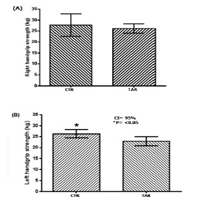Is there an association between upper limb claudication and handgrip strength in Takayasu arteritis?

Submitted: 17 May 2020
Accepted: 29 October 2020
Published: 18 January 2021
Accepted: 29 October 2020
Abstract Views: 755
PDF: 510
Publisher's note
All claims expressed in this article are solely those of the authors and do not necessarily represent those of their affiliated organizations, or those of the publisher, the editors and the reviewers. Any product that may be evaluated in this article or claim that may be made by its manufacturer is not guaranteed or endorsed by the publisher.
All claims expressed in this article are solely those of the authors and do not necessarily represent those of their affiliated organizations, or those of the publisher, the editors and the reviewers. Any product that may be evaluated in this article or claim that may be made by its manufacturer is not guaranteed or endorsed by the publisher.
Similar Articles
- E. Yılmaz, Ö. Pasin, Conventional radiography and correlated factors of enthesopathies of the Achilles tendon and plantar fascia in patients with axial spondyloarthritis , Reumatismo: Early Access
- P. Tomietto, V. Annese, S. D’Agostini, E. Gremese, E. Di Poi, G. Ferraccioli, Neuropsychological tests, MRI and SPECT in the evaluation of CNS involvement in SLE , Reumatismo: Vol. 55 No. 3 (2003)
- L. Quartuccio, M. Fabris, G. Ferraccioli, B Lymphocyte stimulator (BLyS) and monocytes: possible role in autoimmune diseases with a particular reference to rheumatoid arthritis , Reumatismo: Vol. 56 No. 3 (2004)
- M. Vadacca, R. Bruni, F. Caccipaglia, F. Serino, L. Arcarese, F. Buzzulini, G. Coppolino, A. Rigon, N. Terminio, A. Afeltra, Alexithymia and immunoendocrine parameters in patients affected by systemic lupus erythematosus and rheumatoid arthritis , Reumatismo: Vol. 60 No. 1 (2008)
- R. Herrera-Esparza, E. Avalos-Diaz, Infliximab treatment in a case of rheumatoid scleromalacia perforans , Reumatismo: Vol. 61 No. 3 (2009)
- P. Clini, A. Stimamiglio , D. Camellino, E. Hysa, M. Cutolo, M.A. Cimmino, Management of giant cell arteritis among general practitioners from Genoa, Italy: a web-based survey , Reumatismo: Vol. 72 No. 4 (2020)
- A.M. Treichel, D.X. Zheng, G.C. Ranasinghe, A.S. Zeft, W.F. Bergfeld, C.B. Bayart, Eosinophilic fasciitis in a young male auto mechanic exposed to organic solvents , Reumatismo: Vol. 75 No. 3 (2023)
- M. Ponteggia, L. Di Cato, F. Ponteggia, M. Pica, A. Puxeddu, S. Coaccioli, Evaluation of the peak bone mass by quantitative heel ultrasound in young women of the centre of Italy , Reumatismo: Vol. 55 No. 1 (2003)
- R. Foti, R. Leonardi, G. Fichera, M. Di Gangi, C. Leonetti, P. Gangemi, R. De Pasquale, Buschke Scleredema, case report , Reumatismo: Vol. 58 No. 4 (2006)
- V. Gerloni, I. Pontikaki, M Gattinara, F. Fantini, Biological therapy with TNF-inhibitors in pediatric rheumatology. Review of the litterature and personal experience , Reumatismo: Vol. 59 No. 3 (2007)
<< < 26 27 28 29 30 31 32 33 34 35 > >>
You may also start an advanced similarity search for this article.

 https://doi.org/10.4081/reumatismo.2020.1298
https://doi.org/10.4081/reumatismo.2020.1298




